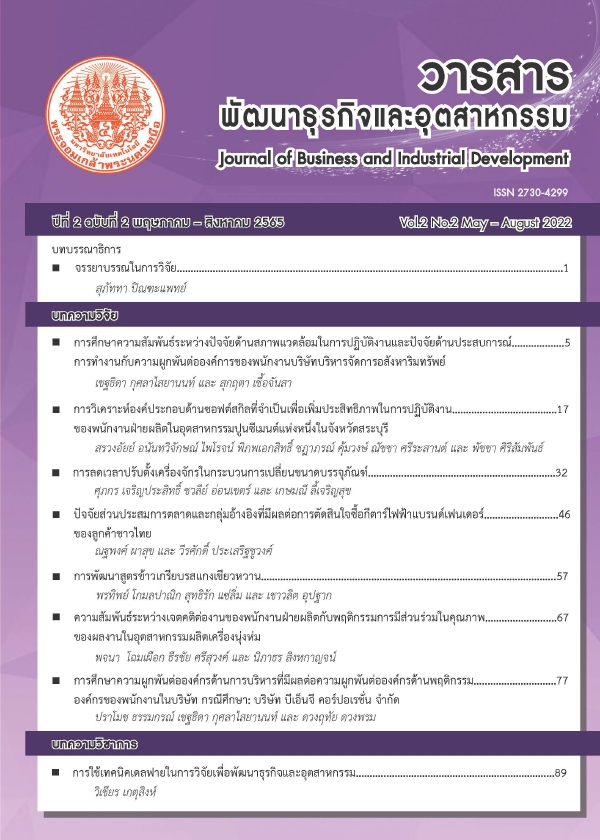Recipe Development of Green Curry-Flavored Rice Crackers
Keywords:
Recipe Development, Rice Crackers, Green CurryAbstract
The objectives of this study were: 1) to select the best rice cracker recipe from 4 basic formulas to develop green curry-flavored rice crackers, 2) to study the appropriate amount of green curry paste in green curry-flavored rice crackers, and 3) to develop a recipe for green curry-flavored rice crackers. This study was a field experimental study. The randomized Complete Block Design, (RCBD) for random trials was planned, using a 9-point scale (9-Point Hedonic Scale questionnaire to express the sensory perception of appearance, color, taste, smell, texture (crispness) and overall preference. The tasters consisted of professors and students in Food and Nutrition Department, Faculty of Home Economics Technology, Rajamangala University of Technology Phra Nakhon. Data were analyzed by mean, variance (Analysis of Variance, ANOVA) and comparing statistical differences by using Duncan's New Multiple Range Test (DMRT). The study found that basic recipe number 1 has received the highest mean preference score at the medium to high levels in terms of appearance, color, taste, texture (crispness) and overall satisfaction at 7.98 7.97 7.93 8.07 8.20 and 8.20, respectively. The analysis for variance and compare statistical differences found that the features in all aspects were statistically significant difference at the 0.05 level. As for the rice cracker seasoning experiment, it was found that the optimum content of green curry paste in the cracker product was 10% of the total weight of the flour. When assessing quality by sensory perception method, it was found at the high level of liking in terms of appearance, color, smell, taste, texture (crispness) and overall liking mean was at 8.49 8.29 8.19 8.38 8.38 and 8.46, respectively. When analyzed for variance and compared statistical differences, the features in all aspects were at a statistically significant difference at the 0.05 level. Green Curry-Flavored Rice Crackers Recipe composes of the basic rice cracker recipe number 1 mixed with 10% green curry paste by weight of rice cracker flour.
References
อภิญญา มานะโรจน์. (2548). ข้าวเกรียบชุดวิชาชีพ. พิมพ์ครั้งที่ 2. สำนักพิมพ์แม่บ้าน, กรุงเทพฯ.
พิมพ์เพ็ญ พรเฉลิมพงศ์. (2546). ข้าวเกรียบ. Foodnetworksolution. http://www.foodnetworksolution.com/wiki/word/3719
ศรีสมร คงพันธุ์. (2560). อาหารไทยธุรกิจ (พิมพ์ครั้งที่ 3). ส.ส.ส.ส, กรุงเทพฯ.
วไลภรณ์ สุทธา. (2559). เอกสารประกอบการสอน วิชาวิทยาศาสตร์การประกอบอาหาร. สาขาวิชาอาหารและโภชนาการ คณะเทคโนโลยีคหกรรมศาสตร์ มหาวิทยาลัยเทคโนโลยีราชมงคลพระนคร, กรุงเทพฯ.
เสาวนีย์ ลาดน้อย และ อบเชย วงศ์ทอง. (2560). การพัฒนากระบวนการผลิตและคุณภาพข้าวเกรียบงาจากปลายข้าวสินเหล็ก. วารสารวิจัยและพัฒนา วไลยอลงกรณ์ ในพระบรมราชูปถัมภ์ สาขาวิทยาศาสตร์และเทคโนโลยี, 12(1).
สกุลตรา ค้ำชู. (2558). ข้าวเกรียบจากแป้งผสมชะครามแห้ง. วารสารบทคัดย่อ กลุ่มวิทยาศาสตร์และเทคโนโลยี, 1(6), 513-523.
สกุลตรา ค้ำชู. (2560). การผลิตน้ำพริกแกง หรือเครื่องแกงเผ็ดของไทยจากพริกหวานสดและแห้งต่อการยอมรับของผู้บริโภค. eresearch.ssru. http://www.eresearch.ssru.ac.th/xmlui/bitstream/handle/
จุฑารัตน์ พงษ์โนรี และ บังอร ธรรมศิริ. (2559). การพัฒนาผลิตภัณฑ์ข้าวเกรียบรากบัว. มหาวิทยาลัยราชภัฎวลัยอลงกรณ์
ทวีทอง หงส์วิวัฒน์. (2559). ไทยจานโปรด. กรุงเทพฯ: สำนักพิมพ์แสงแดด.
จงทิพย์ อธิมุตติศรรค์. (2547). ของว่างไทย. ภูเก็ต: วิทยาลัยอาชีวศึกษาภูเก็ต.
วิภาวรรณ วงศ์สุดาลักษณ์. (2562). การประยุกต์ใช้ฟลาวร์เมล็ดจำปาดะในผลิตภัณฑ์ข้าวเกรียบ. มหาวิทยาลัยราชภัฎสงขลา:ม.ป.ท.
Downloads
Published
How to Cite
Issue
Section
License

This work is licensed under a Creative Commons Attribution-NonCommercial-NoDerivatives 4.0 International License.





